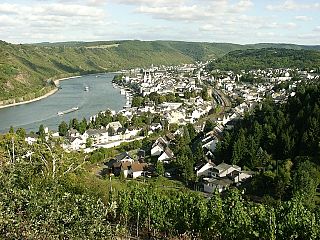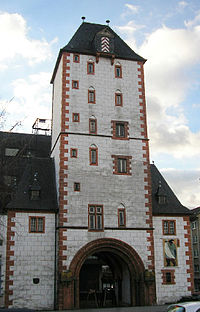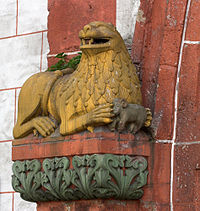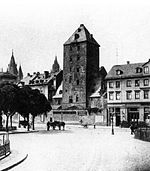
Mainz is the capital and largest city of the German state of Rhineland-Palatinate, and with around 223,000 inhabitants, it is Germany's 35th-largest city. It lies in the Rhine-Main Metropolitan Region—Germany's second-largest metropolitan region after Rhine-Ruhr—which also encompasses the cities of Frankfurt am Main, Wiesbaden, Darmstadt, Offenbach am Main, and Hanau.

Romanesque architecture is an architectural style of medieval Europe that was predominant in the 11th and 12th centuries. The style eventually developed into the Gothic style with the shape of the arches providing a simple distinction: the Romanesque is characterized by semicircular arches, while the Gothic is marked by the pointed arches. The Romanesque emerged nearly simultaneously in multiple countries ; its examples can be found across the continent, making it the first pan-European architectural style since Imperial Roman architecture. Similarly to Gothic, the name of the style was transferred onto the contemporary Romanesque art.

Limes is a term used primarily for the Germanic border defence or delimiting system of Ancient Rome marking the borders of the Roman Empire. The term has been extended in modern times to refer to the frontier defences in other parts of the empire, such as in the east and in Africa.

Aachen Cathedral is a Catholic church in Aachen, Germany and the cathedral of the Diocese of Aachen.

Mainz Cathedral or St. Martin's Cathedral is located near the historical center and pedestrianized market square of the city of Mainz, Germany. This 1000-year-old Roman Catholic cathedral is the site of the episcopal see of the Bishop of Mainz.

The Basel city walls are a complex of walls surrounding the central part of the Swiss city of Basel, only partially preserved today. The first city wall was completed around 1080 under bishop Burkhard von Fenis. A newer wall was constructed around 1230, which is known as the Inner Wall. Its course was mostly identical to the Burkhard wall. In 1362 the construction of a larger wall complex began due to the city's expansion; it was completed in 1398, and is known as the Outer Wall. In 1859 the city's executives decided to raze the inner wall and gates to the ground. Three outer city gates and a short piece of the wall were saved from demolition and are being preserved as part of the city's heritage.

The Pre-Romanesque period in European art spans from the emergence of the Merovingian kingdom around 500 AD, or from the Carolingian Renaissance in the late 8th century, to the beginning of the Romanesque period in the 11th century. While the term is typically used in English to refer primarily to architecture and monumental sculpture, this article will briefly cover all the arts of the period.

Lahnstein is a verband-free town of Rhein-Lahn-Kreis in Rhineland-Palatinate, Germany. It is situated at the confluence of the Lahn with the Rhine, approximately 6 kilometres (3.7 mi) south of Koblenz. Lahnstein was created in 1969 by the merger of the previously independent towns of Oberlahnstein on the south side of the Lahn and Niederlahnstein on the north side. In 2020, it had a population of 18,030.

Boppard, formerly also spelled Boppart, is a town and municipality in the Rhein-Hunsrück-Kreis (district) in Rhineland-Palatinate, Germany, lying in the Rhine Gorge, a UNESCO World Heritage Site. The town is also a state-recognized tourism resort (Fremdenverkehrsort) and is a winegrowing centre.

Mainz Hauptbahnhof is a railway station for the city of Mainz in the German state of Rhineland-Palatinate. It is used by about 60,000 travelers and visitors each day and is therefore by far the busiest station in Rhineland-Palatinate. The station was a trial area for a CCTV scheme using automated face recognition.

The Great Saint Martin Church is a Romanesque Catholic church in Cologne, Germany. Its foundations rest on remnants of a Roman chapel, built on what was then an island in the Rhine. The church was later transformed into a Benedictine monastery. The current buildings, including a soaring crossing tower that is a landmark of Cologne's Old Town, were erected between 1150-1250. The architecture of its eastern end forms a triconch or trefoil plan, consisting of three apses around the crossing, similar to that at St. Maria im Kapitol. The church was badly damaged in World War II; restoration work was completed in 1985.
Imperial cathedral is the designation for a cathedral linked to the Imperial rule of the Holy Roman Empire.

Meckenbach is an Ortsgemeinde – a municipality belonging to a Verbandsgemeinde, a kind of collective municipality – in the Bad Kreuznach district in Rhineland-Palatinate, Germany. It belongs to the Verbandsgemeinde Kirner Land, whose seat is in the town of Kirn.

The Basilica of St. Castor is the oldest church in Koblenz in the German state of Rhineland Palatinate. It is located near Deutsches Eck at the confluence of the Rhine and the Moselle. A fountain called Kastorbrunnen was built in front of the basilica during Napoleon's invasion of Russia in 1812. Pope John Paul II raised St. Castor to a basilica minor on 30 July 1991. This church is worth seeing for the historical events that have occurred in it, its extensive Romanesque construction and its largely traditional furnishings.

The Wood Tower is a mediaeval tower in Mainz, Germany, with the Iron Tower and the Alexander Tower one of three remaining towers from the city walls. Its current Gothic appearance dates to the early 15th century. It is so named because wood used to be piled next to it on the bank of the Rhine.

The church of St. Christoph in Mainz, known in German as St. Christoph zu Mainz, is an example of early gothic architecture. St. Christoph was originally built between 1240 and 1330. The church is associated with Johannes Gutenberg, who may have been baptised there.

The Ingelheim Imperial Palace was an important imperial palace erected in the second half of the 8th century in Germany. It served kings of Francia and later Holy Roman Emperors and Kings as a residenz and place for governance until the 11th century.
The following is a timeline of the history of the city of Mainz, Germany.
The architecture of Switzerland was influenced by its location astride major trade routes, along with diverse architectural traditions of the four national languages. Romans and later Italians brought their monumental and vernacular architecture north over the Alps, meeting the Germanic and German styles coming south and French influences coming east. Additionally, Swiss mercenary service brought architectural elements from other lands back to Switzerland. All the major styles including ancient Roman, Romanesque, Gothic, Renaissance, Baroque, Neoclassical, Art Nouveau, Modern architecture and Post Modern are well represented throughout the country. The founding of the Congrès International d'Architecture Moderne in La Sarraz and the work of Swiss-born modern architects such as Le Corbusier helped spread Modern architecture throughout the world.

The Castra Alteium is a former late-Roman border fort on the Danube-Iller-Rhine Limes (DIRL). It is located in the territory of the city of Alzey in Rhenish Hesse, Germany. The fort was presumably built in the course of the last reconstruction measures on the Rhine frontier between 367 and 370 AD under the western Emperor Valentinian I. Previously, there was a Roman civilian settlement (Vicus), Altiaia, which was devastated by Alamanni in 352–353. The fort was also destroyed twice, and probably abandoned at the end of the fifth century.




















